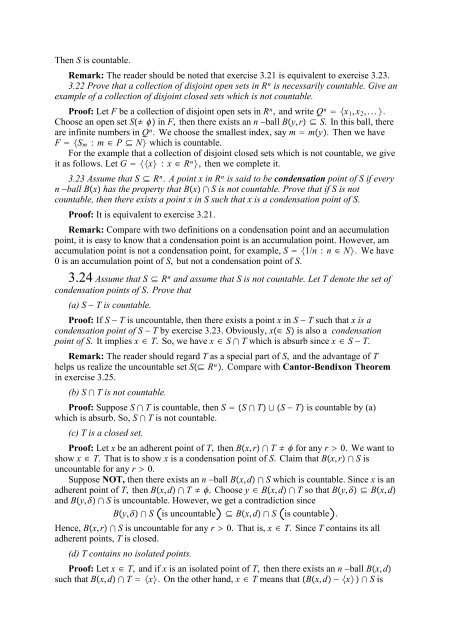The Real And Complex Number Systems
The Real And Complex Number Systems
The Real And Complex Number Systems
Create successful ePaper yourself
Turn your PDF publications into a flip-book with our unique Google optimized e-Paper software.
<strong>The</strong>n S is countable.<br />
Remark: <strong>The</strong> reader should be noted that exercise 3.21 is equivalent to exercise 3.23.<br />
3.22 Prove that a collection of disjoint open sets in R n is necessarily countable. Give an<br />
example of a collection of disjoint closed sets which is not countable.<br />
Proof: Let F be a collection of disjoint open sets in R n , and write Q n x 1 , x 2 ,....<br />
Choose an open set S in F, then there exists an n ball By, r S. In this ball, there<br />
are infinite numbers in Q n . We choose the smallest index, say m my. <strong>The</strong>n we have<br />
F S m : m P N which is countable.<br />
For the example that a collection of disjoint closed sets which is not countable, we give<br />
it as follows. Let G x : x R n , then we complete it.<br />
3.23 Assume that S R n . A point x in R n is said to be condensation point of S if every<br />
n ball Bx has the property that Bx S is not countable. Prove that if S is not<br />
countable, then there exists a point x in S such that x is a condensation point of S.<br />
Proof: It is equivalent to exercise 3.21.<br />
Remark: Compare with two definitions on a condensation point and an accumulation<br />
point, it is easy to know that a condensation point is an accumulation point. However, am<br />
accumulation point is not a condensation point, for example, S 1/n : n N. Wehave<br />
0 is an accumulation point of S, but not a condensation point of S.<br />
3.24 Assume that S R n and assume that S is not countable. Let T denote the set of<br />
condensation points of S. Prove that<br />
(a) S T is countable.<br />
Proof: If S T is uncountable, then there exists a point x in S T such that xisa<br />
condensation point of S T by exercise 3.23. Obviously, x S is also a condensation<br />
point of S. It implies x T. So, we have x S T which is absurb since x S T.<br />
Remark: <strong>The</strong> reader should regard T as a special part of S, and the advantage of T<br />
helps us realize the uncountable set S R n . Compare with Cantor-Bendixon <strong>The</strong>orem<br />
in exercise 3.25.<br />
(b) S T is not countable.<br />
Proof: Suppose S T is countable, then S S T S T is countable by (a)<br />
which is absurb. So, S T is not countable.<br />
(c) T is a closed set.<br />
Proof: Let x be an adherent point of T, then Bx, r T for any r 0. We want to<br />
show x T. That is to show x is a condensation point of S. Claim that Bx, r S is<br />
uncountable for any r 0.<br />
Suppose NOT, then there exists an n ball Bx, d S which is countable. Since x is an<br />
adherent point of T, then Bx, d T . Choose y Bx, d T so that By, Bx, d<br />
and By, S is uncountable. However, we get a contradiction since<br />
By, S is uncountable Bx, d S is countable .<br />
Hence, Bx, r S is uncountable for any r 0. That is, x T. SinceT contains its all<br />
adherent points, T is closed.<br />
(d) T contains no isolated points.<br />
Proof: Let x T, andifx is an isolated point of T, then there exists an n ball Bx, d<br />
such that Bx, d T x. On the other hand, x T means that Bx, d x S is
















